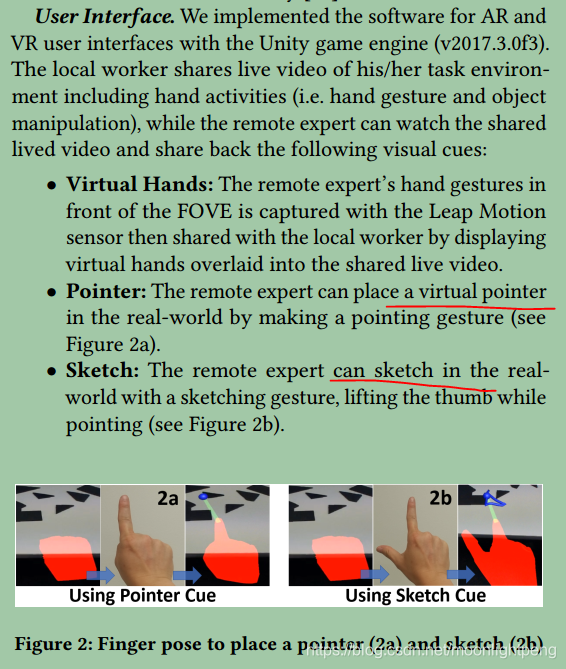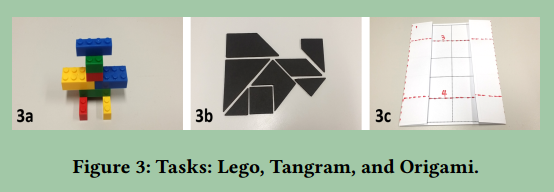Kim S, Lee G, Huang W, et al. Evaluating the Combination of Visual Communication Cues for HMD-based Mixed Reality Remote Collaboration[C]//Proceedings of the 2019 CHI Conference on Human Factors in Computing Systems. ACM, 2019: 173.
Abstract
Many researchers have studied various visual communication cues (e.g. pointer, sketching, and hand gesture) in Mixed Reality remote collaboration systems for real-world tasks. However, the effect of combining them has not been so well explored. We studied the effect of these cues in four combinations: hand only, hand + pointer, hand + sketch, and hand + pointer + sketch, with three problem tasks: Lego, Tangram, and Origami. The study results showed that the participants completed the task signifcantly faster and felt a signifcantly higher level of usability when the sketch cue is added to the hand gesture cue, but not with adding the pointer cue. Participants also preferred the combinations including hand and sketch cues over the other combinations. However, using additional cues (pointer or sketch) increased the perceived mental effort and did not improve the feeling of co-presence. We discuss the implications of these results and future research directions.
INTRODUCTION
目前AR/MR远程协同的做法,简炼的概括
In a typical remote collaboration study with a real-world physical task (e.g. fxing a car or making a Lego model), there are two main participants: a local user in the task space and a remote collaborator [10, 26–28]. While the local user directly performs activities in the local task space, the remote collaborator could use technology (such as video conferencing) to see a view of the task space and use visual cues to aid communication. Typical visual communication cues are pointers [29, 35, 42], sketches [12, 13, 26–28], and hands [1, 20, 32, 44], and many researchers have explored the effect of these cues individually in remote collaboration studies.
指出其中的问题所在,从而引出自己的研究点
However, to the best of our knowledge, there is no previous study investigating the effect of combining the common visual cues (i.e. pointer, sketching and hand gestures) together in Mixed Reality (MR) remote collaboration. In this paper, we explore and compare four different combinations: 1) hand only, 2) hand + pointer, 3) hand + sketch, and 4) hand + pointer + sketch - a 2 x 2 factorial design study where the hand gesture cue is the baseline condition with two independent variables (Pointer and Sketch) with each variable having two levels (On or Off).
研究的贡献
(1) Design and implementation of a prototype MR system supporting both local and remote collaborators wearing a head mounted display (HMD) and using combination of visual cues including the pointer, sketch, and virtual hand
(2) Comparing four combinations of the typical visual communication cues (virtual pointer, sketch, and hand representation) with three physical tasks (Lego blocks, Tangram puzzle, and Origami) in MR remote collaboration. (3) Measuring the effect of the combinations of visual cues on the co-presence and required mental effort
METHODOLOGY



RESULTS






DISCUSSION
这篇论文的discussion写的非常的详实,写论文的参考一下。
CONCLUSIONS
In this paper, we compared four combinations of the visual cues (hand only, hand + pointer, hand + sketch, and hand + pointer + sketch) in the MR remote collaboration system with three task scenarios (assembling Lego, assembling a Tangram, and origami tasks). The results showed that by adding sketch cue to the hand gesture cue participants completed the task faster and felt a higher level of usability. On the other hand, adding pointer cue did not provide any signifcant beneft on the performance or usability. There was no signifcant effect of the two additional cues on the level of co-presence, and participants felt higher level of required mental effort when using the additional visual cues. With the result, we suggest not to use the frequently used hand poses (e.g. pointing pose with index fnger) to trigger additional pointer or sketch cue. In the future, we will extend our study by comparing independent and dependent views while using the three visual communication cues.
来源:https://blog.csdn.net/moonlightpeng/article/details/100846554
